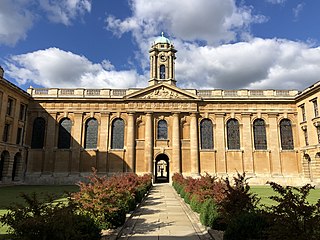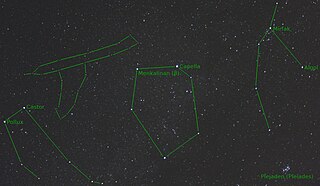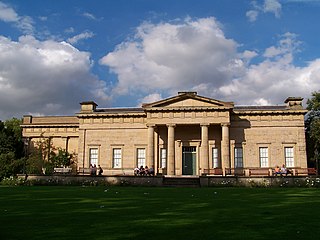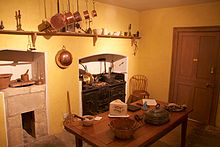
Frederick William Herschel was a German-British astronomer and composer. He frequently collaborated with his younger sister and fellow astronomer Caroline Herschel. Born in the Electorate of Hanover, William Herschel followed his father into the military band of Hanover, before emigrating to Great Britain in 1757 at the age of nineteen.

Sir John Frederick William Herschel, 1st Baronet was an English polymath active as a mathematician, astronomer, chemist, inventor, and experimental photographer who invented the blueprint and did botanical work.

Uranus is the seventh planet from the Sun. It is a gaseous cyan-coloured ice giant. Most of the planet is made of water, ammonia, and methane in a supercritical phase of matter, which in astronomy is called 'ice' or volatiles. The planet's atmosphere has a complex layered cloud structure and has the lowest minimum temperature of 49 K out of all the Solar System's planets. It has a marked axial tilt of 97.8° with a retrograde rotation rate of 17 hours. This means that in an 84-Earth-year orbital period around the Sun, its poles get around 42 years of continuous sunlight, followed by 42 years of continuous darkness.

An orrery is a mechanical model of the Solar System that illustrates or predicts the relative positions and motions of the planets and moons, usually according to the heliocentric model. It may also represent the relative sizes of these bodies; however, since accurate scaling is often not practical due to the actual large ratio differences, a subdued approximation may be used instead. Though the Greeks had working planetaria, the first orrery that was a planetarium of the modern era was produced in 1713, and one was presented to Charles Boyle, 4th Earl of Orrery – hence the name. They are typically driven by a clockwork mechanism with a globe representing the Sun at the centre, and with a planet at the end of each of the arms.

The Queen's College is a constituent college of the University of Oxford, England. The college was founded in 1341 by Robert de Eglesfield in honour of Philippa of Hainault, queen of England. It is distinguished by its predominantly neoclassical architecture, primarily dating from the 18th century.

Caroline Lucretia Herschel was a German-born British astronomer, whose most significant contributions to astronomy were the discoveries of several comets, including the periodic comet 35P/Herschel–Rigollet, which bears her name. She was the younger sister of astronomer William Herschel, with whom she worked throughout her career.
Herschel or Herschell may refer to:

Hill Top is a 17th-century house in Near Sawrey near Hawkshead, in the English county of Cumbria. It is an example of Lakeland vernacular architecture with random stone walls and slate roof. The house was once the home of children's author and illustrator Beatrix Potter who left it to the National Trust. It is a Grade II* listed building. It is open to the public as a writer's house museum, shown as Beatrix Potter herself would have known it.

Telescopium Herschelii, also formerly known as Tubus Hershelli Major, is a former constellation in the northern celestial hemisphere. Maximilian Hell established it in 1789 to honour Sir William Herschel's discovery of the planet Uranus. It fell out of use by the end of the 19th century. θ Geminorum at apparent magnitude 4.8 was the constellation's brightest star.

Stowe House is a grade I listed country house in Stowe, Buckinghamshire, England. It is the home of the private Stowe School and is owned by the Stowe House Preservation Trust. Over the years, it has been restored and maintained as one of the finest country houses in the UK. Stowe House is regularly open to the public.

Beckford's Tower, originally known as Lansdown Tower, is an architectural folly built in neo-classical style on Lansdown Hill, just outside Bath, Somerset, England. The tower and its attached railings are designated as a Grade I listed building. Along with the adjoining Lansdown Cemetery it is Grade II listed on the Register of Historic Parks and Gardens of special historic interest in England.

King John's Hunting Lodge is a wool-merchant's house built c. 1460, long after the death of King John in 1216, in Axbridge, a town in the English county of Somerset. It is a jettied timber-frame building of three storeys, occupying a corner plot on the town square. The building has served a variety of purposes with shops on the ground floor and workshops and living quarters on the first and second floors. At one time part of the building was occupied by the King's Head Inn; a sculpture of a king's head, which acted as a sign for the pub, is preserved within and a replica is attached to the outside. The lodge was bequeathed to the National Trust in 1971, and repairs were undertaken to reverse significant deterioration to the building.

The Bath Preservation Trust is a charity that is based in Bath, Somerset, England, which exists to safeguard for the public benefit the historic character and amenities of the city, a UNESCO World Heritage Site, and its environs. BPT is independent, funded by public membership, grants, donations and income from four museums that it operates in Bath: No. 1 Royal Crescent, the Museum of Bath Architecture, Beckford's Tower, and the Herschel Museum of Astronomy.

The Yorkshire Museum is a museum in York, England. It was opened in 1830, and has five permanent collections, covering biology, geology, archaeology, numismatics and astronomy.
6395 Hilliard, provisional designation 1990 UE1, is a stony Nysian asteroid from the inner regions of the asteroid belt, approximately 4.5 kilometers in diameter.

William Herschel's 40-foot telescope, also known as the Great Forty-Foot telescope, was a reflecting telescope constructed between 1785 and 1789 at Observatory House in Slough, England. It used a 48-inch (120 cm) diameter primary mirror with a 40-foot-long (12 m) focal length. It was the largest telescope in the world for 50 years. It may have been used to discover Enceladus and Mimas, the 6th and 7th moons of Saturn. It was dismantled in 1840 by Herschel's son John Herschel due to safety concerns; today the original mirror and a 10-foot (3.0 m) section of the tube remain.

Observatory House was the name of an 18th-century observatory established by William and Caroline Herschel in Windsor Street, Slough. After the original building had been demolished, the name was re-applied to a modern office block on the same site which now serves as the headquarters of Slough Borough Council.

The Royal Observatory of Madrid is a historic observatory situated on a small hill next to the Buen Retiro Park in Madrid, Spain. It was founded in 1790 and has been engaged in continuous scientific activity since then. It is currently the seat of the Spanish National Observatory and an active research group in geophysics, both belonging to the National Geographic Institute.
























